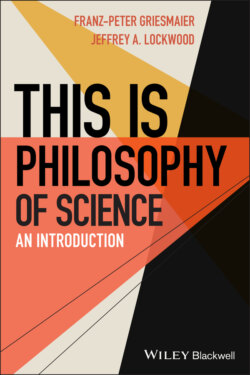Читать книгу This is Philosophy of Science - Franz-Peter Griesmaier - Страница 37
3.2.1 Confirmation through Predictive Success
ОглавлениеOne influential proposal for how to understand this process is Carl Gustav Hempel’s model of theory confirmation. It basically reduces confirmation to a two-step process. First, a scientist generates testable predictions from a theory. Second, the researcher determines whether or not those predictions are borne out by appropriate observations, which of course include measurement results and experimental outcomes. For Hempel, the first step was a matter of deductive logic. Here’s an example.
Suppose that you want to defend the theory that the earth is spherical. The ancient philosopher Aristotle was one of the first to describe a test for this theory. The idea behind his attempt at confirmation is very simple. If the earth were spherical, we’d expect to see a ship that leaves the harbor to not only look smaller and smaller as it sails away, but to also disappear nonuniformly over the horizon. At the appropriate distance, we might be able to still make out the masts and the sails without seeing the hull of the ship anymore. So, the theory “The earth is spherical” predicts a partial disappearance of the ship. If you go to the harbor, you can actually make this observation – the ship disappears from the bottom-up, and the theory has been confirmed by this observation.
Hempel summarized and generalized this example, and others, into the following model of theory confirmation:
Theory predicts Observation
Observation is made
Theory is (better) confirmed
The first thing to notice here is that confirmation is different from proof. If a theory entails an observation and the observation is made, it doesn’t logically follow that the theory is true. To think otherwise would be to commit a logical fallacy. To see this, consider: “If it rains, the streets are wet. The streets are wet. Thus, it is raining.” But the conclusion doesn’t follow from the premises, because someone could have hosed down the streets, and that’s why they are wet. However, if the prediction is borne out, we can say that the theory has been confirmed to a certain degree. This in turn means that we have some reason for believing the theory.
Here’s another example following the same pattern. Suppose I want to confirm the hypothesis that all ravens are black. How would I do this? Following Hempel’s advice, I infer a prediction from my hypothesis and then determine whether it is true or not. What follows from the claim that all ravens are black? One thing that comes to mind immediately is that the next raven I see will be black. Thus,
Raven Theory predicts “Next raven is black”
Observation “Next raven is black” is made
Raven Theory is (better) confirmed
What’s important about this second example is that the theory talks about all ravens – past, present, and future, and everywhere they exist. Suppose I have seen 200 ravens, and all of them have been black. Thus, I inductively infer my Black Raven theory. Now I want to confirm it by using Hempel’s procedure, as we have just done. But, seriously, how much of a confirmation can that one black raven provide? Remember, my theory talks about all ravens.
